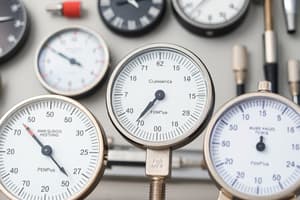Podcast
Questions and Answers
What is the main purpose of measuring instruments?
What is the main purpose of measuring instruments?
- To measure physical quantities (correct)
- To convert physical quantities into signals
- To provide physical quantities
- To amplify physical quantities
What type of instrument provides discrete numerical values?
What type of instrument provides discrete numerical values?
- Analogue instrument
- Digital instrument (correct)
- Measuring instrument
- Thermometer
What is a systematic error in instrumentation?
What is a systematic error in instrumentation?
- Error due to unpredictable fluctuations
- Error due to instrumental calibration
- Error due to instrumental limitations (correct)
- Error due to instrumental maintenance
What is the unit of length in the International System of Units?
What is the unit of length in the International System of Units?
What is the unit of thermodynamic temperature in the International System of Units?
What is the unit of thermodynamic temperature in the International System of Units?
What is the purpose of prefixes in the International System of Units?
What is the purpose of prefixes in the International System of Units?
What is a derived unit in the International System of Units?
What is a derived unit in the International System of Units?
Flashcards are hidden until you start studying
Study Notes
Instrumentation
- Measuring Instruments: Devices used to measure physical quantities, such as length, time, temperature, and pressure.
- Types of Instruments:
- Analogue Instruments: Provide continuous signals, e.g., thermometers and ammeters.
- Digital Instruments: Provide discrete numerical values, e.g., digital multimeters and oscilloscopes.
- Instrumental Errors:
- Systematic Errors: Errors due to instrumental limitations, e.g., zero-point error.
- Random Errors: Errors due to unpredictable fluctuations, e.g., thermal noise.
SI Units
- International System of Units: A standardized system of measurement units, adopted globally.
- Base Units:
- Meter (m): Unit of length.
- Kilogram (kg): Unit of mass.
- Second (s): Unit of time.
- Ampere (A): Unit of electric current.
- Kelvin (K): Unit of thermodynamic temperature.
- Mole (mol): Unit of amount of substance.
- Candela (cd): Unit of luminous intensity.
- Derived Units: Units derived from base units, e.g., velocity (m/s), force (N), and energy (J).
- Prefixes: Used to indicate multiples and fractions of units, e.g., kilo- (10^3), centi- (10^-2), and nano- (10^-9).
Instrumentation
- Measuring instruments are devices used to measure physical quantities such as length, time, temperature, and pressure.
- Analogue instruments provide continuous signals, examples include thermometers and ammeters.
- Digital instruments provide discrete numerical values, examples include digital multimeters and oscilloscopes.
- Systematic errors occur due to instrumental limitations, such as zero-point error.
- Random errors occur due to unpredictable fluctuations, such as thermal noise.
SI Units
- The International System of Units is a standardized system of measurement units adopted globally.
- The base unit of length is the meter (m).
- The base unit of mass is the kilogram (kg).
- The base unit of time is the second (s).
- The base unit of electric current is the ampere (A).
- The base unit of thermodynamic temperature is the kelvin (K).
- The base unit of amount of substance is the mole (mol).
- The base unit of luminous intensity is the candela (cd).
- Derived units are units derived from base units, examples include velocity (m/s), force (N), and energy (J).
- Prefixes are used to indicate multiples and fractions of units, examples include kilo- (10^3), centi- (10^-2), and nano- (10^-9).
Studying That Suits You
Use AI to generate personalized quizzes and flashcards to suit your learning preferences.




